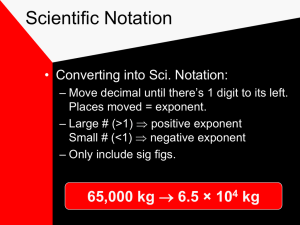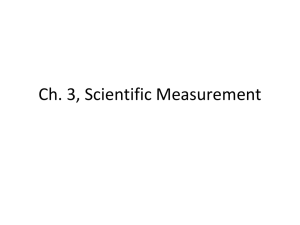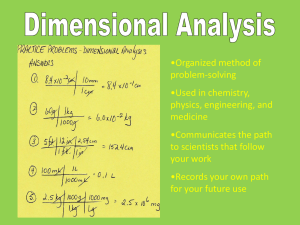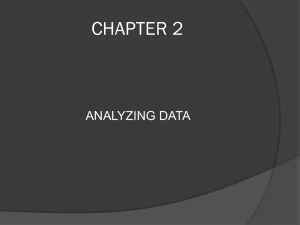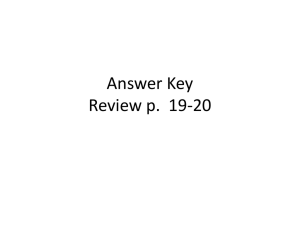Calculations with Significant Figures
advertisement
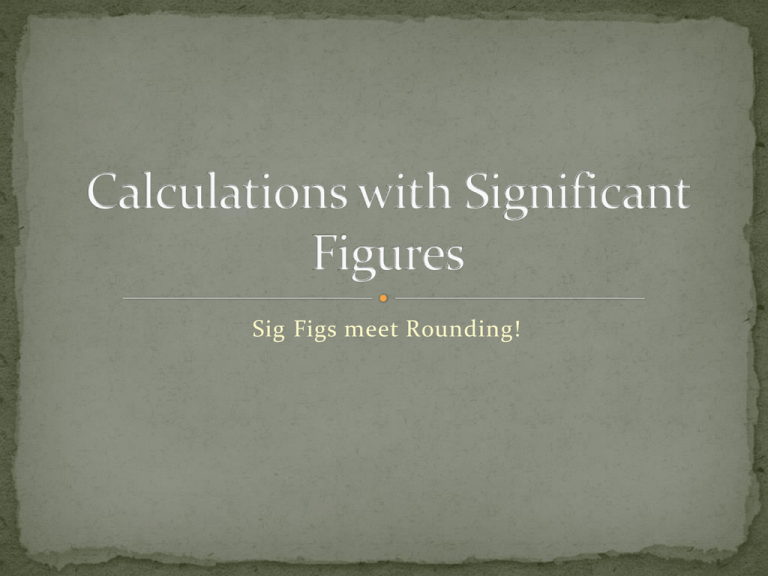
Sig Figs meet Rounding! In Science we take measurements, but those measurements are sometimes needed to find the values that we really want. For example: Volume (Length x Width x Height) Volume by Difference using a graduated cylinder (Height of Water with object – Height of water initially) Density (Mass ÷ Volume) Calculations cannot be more precise than the measurements. The least precise measurement dictates the precision of the answer The least precise will be the measurement with the LEAST decimal places. When adding or subtracting – pretend that you are back in elementary school and line those numbers up! Example: Two different pieces of metal are massed separately using different balances. The first piece has a mass of 19.473 g. The second piece has a mass of 3.82 g. What is the total mass? Don’t forget to use significant figures. Step 1 – Line them up and do the math. 19.473 + 3.82 23.293 Step 2 – Find the LAST significant figure. Start from the right. Look for the first column that has a significant figure from both measurements. Underline the number in the answer that is in that column. 19.473 + 3.82 23.293 Step 3 – Round to that place – do not forget to LOOK right! 19.473 + 3.82 23.293 Answer : 23.29 g – Don’t forget the Unit!!! Subtraction is the SAME!!! Example – The mass of a paper cup is 1.284 g. The mass of the paper cup plus a sample of Manmium is 38.2 g. What is the mass of the Manmium sample? Step 1 – What is it? Yep – Line them up! 38.2 - 1.284 36.916 Step 2 – What is it? Yep – Underline the last significant figure! 38.2 - 1.284 36.916 Step 3 – What is it? Yep – Look right and ROUND! 38.2 - 1.284 36.916 Answer = 36.9 g 489.2 g + 8.03 g = ? 0.2800 L + 4.8 L =? 285.0 kg – 3.82 kg = ? 0.01963 g + 0.290 g =? 926.028 kg – 30.02 kg = ? 3902 L + 284.5 L = ? 489.2 g + 8.03 g = 497.2 g 0.2800 L + 4.8 L = 5.1 L 285.0 kg – 3.82 kg = 281.2 kg 0.01963 g + 0.290 g = 0.310 g 926.028 kg – 30.02 kg = 896.01 kg 3,902 L + 284.5 L = 4,186 L The least precise measurement dictates the precision of the answer The least precise will be the measurement with the LEAST number of significant figures. The answer should be rounded to the least number of significant figures Example: Find the area of a rectangle with a length of 24.35 m and a width of 4.09 m. Step 1 – Do the math! Area = Length x width 24.35 m x 4.09 m = 99.5915 m2 Step 2 – Determine the number of significant figures in the original measurements 24.35 m (4 sig figs) 4.09 m (3 sig figs) Step 3 – Determine the least number of sig figs 3 sig figs is less than 4 sig figs Step 4 – round the answer to the least number of sig figs that you determined in Step 3 99.5915 m2 Final Answer – 99.6 m2 Division is the same! Example – An object has a mass of 48.309 g and a volume of 9.28 mL. What is the density of this object? What is Step 1? Yep – do the math! Density = mass/volume Density = 48.309 ÷ 9.28 = 5.20571121 g/mL What is Step 2? Yep – determine the number of significant figures in each of the original measurements 48.309 g (5 sig figs) 9.28 mL ( 3 sig figs) What is Step 3? Yep – determine the least number of sig figs in the original measurements 3 sig figs What is Step 4? Yep – Round to the least number of sig figs found in Step 3 5.20571121 g/mL round to three sig figs Final Answer = 5.21 g/mL 40.38 cm x 3.2903 cm = ? 0.00382 m x 0.08291 m = ? 293.0 g ÷ 3.0023 cm3 = ? 3.0193 x 104 kg ÷ 4.93 L = ? 293.0 cm x 3.28 cm = ? Challenge: 3.927 cm x 12.736 cm x 4.000 cm = ? 40.38 cm x 3.2903 cm = 132.9 cm2 0.00382 m x 0.08291 m = 0.000317 m2 or 3.17 x 10-4 m2 293.0 g ÷ 3.0023 cm3 = 97.59 g/cm3 3.0193 x 104 kg ÷ 4.93 L = 6,120 kg/L or 6.12 x 103 kg/L 293.0 cm x 3.28 cm = 89.3 cm2 Challenge: 3.927 cm x 12.736 cm x 4.000 cm = 200.1 cm3





